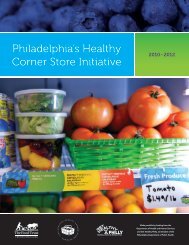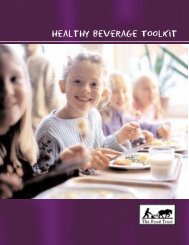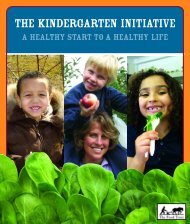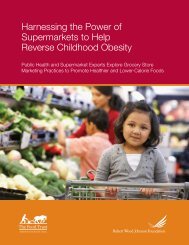The Grocery Gap: Who Has Access to Healthy - The Food Trust
The Grocery Gap: Who Has Access to Healthy - The Food Trust
The Grocery Gap: Who Has Access to Healthy - The Food Trust
You also want an ePaper? Increase the reach of your titles
YUMPU automatically turns print PDFs into web optimized ePapers that Google loves.
PolicyLink<strong>The</strong> <strong>Food</strong> <strong>Trust</strong>MethodsBetween May and July 2009, PolicyLink and<strong>The</strong> <strong>Food</strong> <strong>Trust</strong> created a comprehensivebibliography of studies related <strong>to</strong> food accessand/or food access and health across theUnited States. Unlike previous review studies,which typically only include published work, wesought <strong>to</strong> include “grey literature,” or studies,reports, and analyses that are not published inpeer-reviewed journals. Public health agencies,community-based organizations, and policygroups frequently conduct primary data analysesof retail food access <strong>to</strong> inform their activities,but generally do not take the additional steps <strong>to</strong>submit their studies <strong>to</strong> journals for publication.We used the following search methods<strong>to</strong> compile the bibliography:• Sent requests for information <strong>to</strong> relevantlistservs, e.g., COMFOOD, the NationalNeighborhood Indica<strong>to</strong>rs Partnership(NNIP), American Evaluation Association(EVALTALK), and agency email lists;• Wrote <strong>to</strong> 80 food policy councils acrossthe country that are listed on the NorthAmerican <strong>Food</strong> Policy Council websiteand the Community <strong>Food</strong> SecurityCoalition <strong>Food</strong> Policy Council Database;• Contacted several foundations andleaders working in the food access field;• Searched PubMed and other librarydatabases related <strong>to</strong> the fields ofplanning, community development, andgeography <strong>to</strong> identify formally publishedwork related <strong>to</strong> urban and rural foodaccess and health implications; and• Reviewed reference lists of included studies.In order <strong>to</strong> be included, each study needed<strong>to</strong> meet the following criteria:• Related directly or indirectly <strong>to</strong> identifyingdisparities in access <strong>to</strong> food retailersor healthy food, and the relationshipbetween food retail and health;• Either included original research onthese <strong>to</strong>pics or reviewed other studies;• Conducted in the United States (while therehave been studies conducted outside ofthe United States, the persistent trend ofresidential segregation by race/ethnicity andincome in this country makes extrapolationfrom these studies of limited value); and• Published during or after 1995 (althoughwe included a few important studies thatwere conducted between 1990 and 1994).One hundred and thirty-two studies were ultimatelyincluded in the database, of 168 articles initiallygathered through the search methods above. Weincluded studies that use random and nonrandomsampling methods and quantitative and qualitativetechniques (such as resident interviews). We alsoincluded studies that examine single communities ofinterest (alone or in comparison <strong>to</strong> other areas). Weexcluded newsletters, policy statements, and studiesthat focused on methods and measurements. Inone case we found two policy papers, one shorterthan the other, based on the same study and data;they were counted as one study in the database.Of the studies selected for the database, 61 werepublished in peer-reviewed journals, and 71 fellin<strong>to</strong> the grey literature category. We did notsystematically review the evidence quality (e.g.,sample size, strength of methods used) of each23






